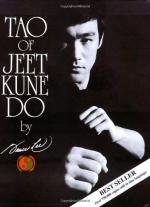
|
| Name: _________________________ | Period: ___________________ |
This test consists of 15 multiple choice questions and 5 short answer questions.
Multiple Choice Questions
1. What does Lee claim is a denial of one's being?
(a) Selfless.
(b) Becoming.
(c) Sacrifice.
(d) Martyrdom.
2. According to Lee, how should the movements of an opponent who is very fast and cannot be feinted, be countered?
(a) With the bind.
(b) With the croise.
(c) With a feint.
(d) With the beat.
3. The two parts in a feint are a _____ thrust and a _____ evasive thrust.
(a) Large/Small.
(b) False/Real.
(c) Powerful/Weak.
(d) First/Second.
4. Lee believes that footwork during fighting is preferable to _____.
(a) Circling.
(b) Upper body work.
(c) Standing still.
(d) Parrying.
5. What does Lee say changes continuously with the speed, agility, and control of fighters?
(a) Distance.
(b) Mobility.
(c) Energy.
(d) Advantage.
6. Which attacks does Lee describe that are started by the fighter to score by pace, fraud, or force?
(a) Counter.
(b) Simple.
(c) Compound.
(d) Primary.
7. Lee believes one should keep his mind in a state of _____ so the freedom of action is never _____.
(a) Consciousness/Affected.
(b) Joy/Impacted.
(c) Contemplation/Disturbed.
(d) Emptiness/Obstructed.
8. What does Lee say a long and deep feint draws the opponent into?
(a) A feint.
(b) A trance.
(c) A corner.
(d) A parry.
9. Lee says that the tools of Jeet Kune Do are at the center of an undefined circle whose circumference allows _____.
(a) Continuous expansion outward.
(b) A series of circles to become one.
(c) One to spiral out of control.
(d) One to find peace within.
10. Lee teaches that in Jeet Kune Do, combat is a matter of _____.
(a) Interpretation.
(b) Footwork.
(c) Motion.
(d) Following the rules.
11. What does Lee say is made when a fighter decides or opponent movement occurs or fails?
(a) An attack.
(b) Progress.
(c) A point.
(d) A counter attack.
12. What does Lee say fighters may develop to maintain the distance between them?
(a) A mental yardstick.
(b) Body feel.
(c) Rhythm.
(d) An instinctive reflex.
13. What is a counterattack that follows a parry and is determined by the opponent's anticipated reactions?
(a) Riposte.
(b) Weaving.
(c) Immobilization attack.
(d) Renewed attack.
14. What does Lee say is the highest priority as techniques mastered are forgotten to float in totality?
(a) Excitement.
(b) Discipline.
(c) Concentration.
(d) Emptiness.
15. What is a balanced forward advance of the body through a series of short sliding steps forward?
(a) The side shuffle.
(b) A lunge.
(c) A feint.
(d) The forward shuffle.
Short Answer Questions
1. What action does Lee say the feint lures the opponent into making?
2. Where should the execution of the feint start from?
3. What move does Lee say can be used to open the line by force or to feint before an attack?
4. What follows with the fighter lunging?
5. According to Lee, how are the psychic hindrances of man and surroundings eliminated?
|
This section contains 478 words (approx. 2 pages at 300 words per page) |

|




